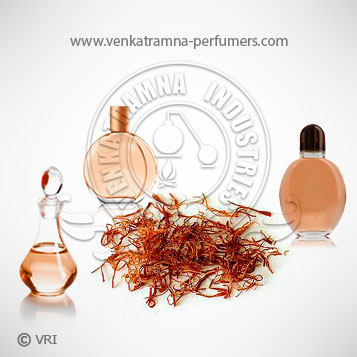
| Botanical Name | Crocus sativus |
| Common Name | Safflower , American saffron , zafran , bastard saffron , false saffron , dyer's saffron , Gami Honghwain . |
| Country of Origin | Southwest Asia |
| Solubility | In Alcohol and Fixed / Carrier Oils |
| Specific Gravity | @ 25 °C, 0.910-0.915 |
| Optical Rotation | (20°C), -5° to +10° |
| Refrective Index | (20?). 1.476 - 1.480 |
| PlantPart | crocus |
| Bland With | It is only partially soluble in alcohol and fixed/carrier oils. |
| CAS No | 42553-65-1 |
| Flash Point | 95 °C |
| Extraction Method | Steam Distilled |
Saffron is known to be one of the most expensive spices. This is because the stigmas of the plant are handpicked to make the spice. Saffron oil has a very interesting odour. It has a woody, spicy, hay like odour.
Although the origins of saffron are disputed to where it comes from, but considering the way that the Sowing takes place in the months of June and July and must be hot followed by The harvesting that takes place between the end of October-beginning of November and must be start of winter and should be cold. This makes Iranian weather condition perfect for this species of plant. Most confirm that it comes from Orient, because its cultivation was widely spread in Minor Asia far before the birth of Christ. Human cultivation and use of saffron reaches back more than 3,500 years and spans many cultures, continents, and civilizations. Saffron, a spice derived from the dried stigmas of the saffron crocus (Crocus sativus), has remained among the world's most costly substances throughout history. With its bitter taste, hay-like fragrance, and slight metallic notes, saffron has been used as a seasoning, fragrance, dye, and medicine
Color : Light Yellow / Golden, Spicy Smell Similar To That Of Hay,
Aroma : relax, helpful
Saffron contains the carotenoids crocin and crocetin, which are responsible for the reddish orange color of the stigmas. The stigmas also contain the aromatic essential oil safranal. Other constituents of saffron are cineol and pinene, as well as the substance picrocrocin (saffron bitters). Saffron is also high in thiamine and riboflavin.
Saffron oil is used for external application in uterine sores. Remanent water after extracting oil from it is also used as medicine